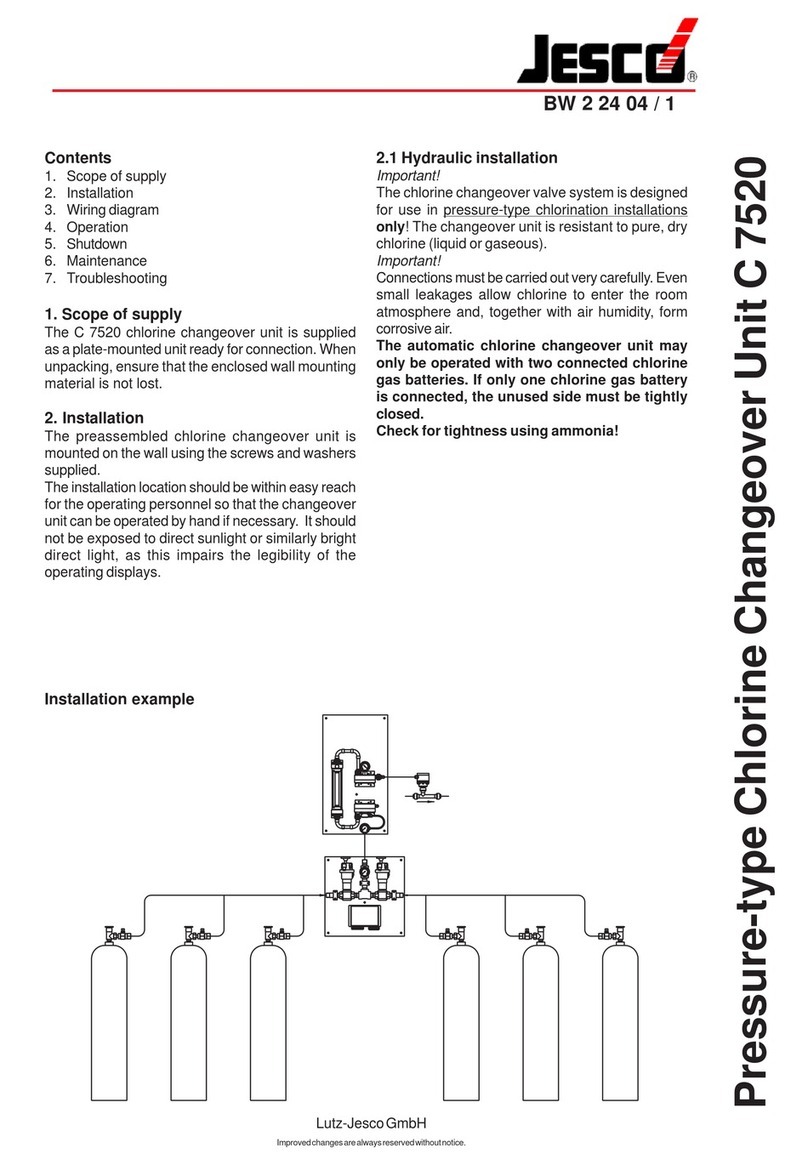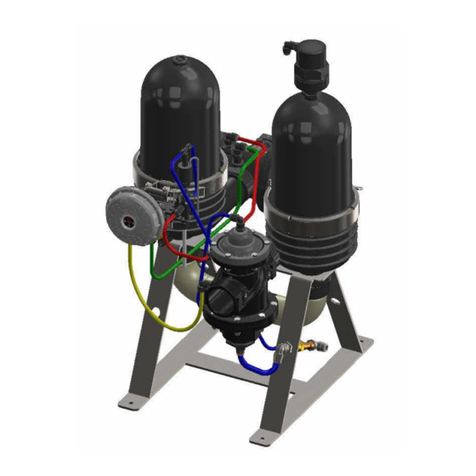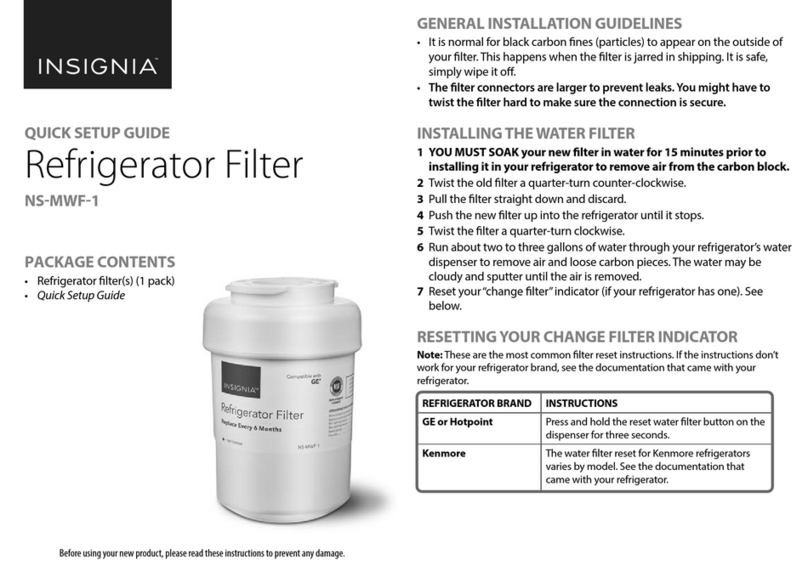Jesco C 2700 Manual

Chlorinator C 2700
BW 2 03 01 / 1
Injection Nozzle
The chlorine injection fittings or chlorine solution injectors
are made from PVC and are fitted with a shutoff valve
(ball cock) and injection piping, which, for installation, is
shortened to half of its diameter with a 45° diagonal cut.
The injection nozzles are integrated either in water-
bearing lines or in open basins at such points where
turbulences enable a good mixture.
For injection into open basins, drains or induction
manifolds, long, perforated pipes closed at the end are
suitable, which are tied to the bottom under water. Thus
a fine and large-area distribution can be ensured.
Safety Blowoff Line
The PE tubing, which is part of the packing unit, is
connected to the center chamber of the chlorinator and
either laid outside with inclination or led to the sensor of
the gas warning device (25), depending on the local
conditions. The tubing is used to carry off chlorine gas,
if the safety valve installed in the center chamber of the
chlorinator has responded.
Gas Supply
Direct Gas Delivery
Chlorine is available in steel cylinders of 65 kg and steel
barrels of 500 and 1,000 kg. Because of the large
quantities required, we recommend to use always barrels,
as only 1 % of the contents may be delivered hourly as
gas at a temperature of 20° C. For chlorine deliveries of
up to 25 kg/h, at least 3 barrels of 1,000 kg should be
connected for direct gas supply.
Operating and Maintenance Instructions
Packing
The C 2700 equipment is packed individually because of
its size and variable accessories. Refer to the delivery
note for the actual scope of delivery.
Notes on Installation
Before installation carefully check the location in which
the chlorinator and tank are to be mounted, according to
the directions of the local authorities. In general, the
standardized safety rules for "Chlorination of Water"
apply.
—Chlorine tank and chlorinator must be located in
different rooms.
—The floors of these rooms must not be underground.
— Escaping chlorine gas must not enter other lower
rooms, wells, mines or drains.
— The chlorine rooms must not be connected to other
rooms. A fireproof and gastight separation is required.
Make sure that the doors open outwards and always
without a key from inside.
— Each room is to be provided with small ventilation
openings in the floor and ceiling. These openings
must directly lead outside, and their cross sections
should not exceed 40 cm2.
— In the case of unfavourable locations, e.g. near
schoolyards or rest-cure meadows, gas warning
devices with visual and acoustic signaling are to be
installed instead of ventilation openings. They must
be coupled with an automatic sprinkler system.
Delayed activation is admissible.
—It is important to use always appropriate tools. Make
sure that two fixed spanners are used for detaching
and connecting chlorine lines in order to avoid
unadmissible loading of the device components.
Ejector Water Supply
The numbers mentioned below refer to the schematic
diagram on page 6.
In order to operate a full-vacuum chlorinator, the ejector
(14) must be provided with the appropriate motive water
pressure and the corresponding quantity of motive water.
For the accurate values, see the characteristic curves for
ejectors. If the existing water pressure is not sufficient
according to the ejector data sheet, a booster pump (20)
must be connected. The non-return valve (13) mounted
on the ejector prevents the motive water to return to the
chlorine gas vacuum line if the motive water supply is
switched off or if the ejector is faulty.
As it cannot be excluded that the non-return valve leaks
due to contamination, a motor ball cock (12) must be
opened in dependence on the booster pump (20). Before
entering the ejector, the line must be straight approx.
20 x DN in axial direction of the ejector. A dirt trap with a
mesh aperture of less than 0.5 mm should be used in any
case, no matter if a booster pump is part of the installation
or not.
Chlorine Solution Line
The chlorine solution produced in the ejector is led to the
the injection nozzle (16) via a PVC piping and non-return
valve (15). After the ejector, the line should be straight (5
x DN). In order to avoid pressure losses in the solution
line, use as little bends and fittings as possible.
Chlorine solution from ejector perforated pipe
e.g. cooling-water basin
Chlorine Evaporation
Liquid chlorine deliveries are recommended for quantities
of more than 25 kg/h. With the help of an evaporator (see
MB 2 05 01), the liquid chlorine is converted into gas by
electrical heating and then led to the chlorinator as
described before.
Shutoff valve Injection
piping
1/2 DN
Lutz-Jesco GmbH
Improved changes are always reserved without notice.

Chlorinator C 2700
BW 2 03 01 / 2
Storage of the chlorine barrels and connection of the
chlorinators
The barrels have to be stored horizontally on supports.
Remove the protective cap of the valve right before
connection of the lines.
Caution:
Make sure that the gas supply of the barrel is connected
and not the liquid chlorine supply if no evaporator is
used.
The barrels are marked with a stripe which must be
horizontal when the barrel is positioned in the support.
The upper connection is always used for chlorine gas,
the lower connection delivers liquid chlorine for evaporator
operation.
Use always new sealings for the connection of lines and
fittings. The flexible copper lines must be cut off
rectangularly at both ends and inserted very carefully into
the screwings with cutting ring.
The threaded coupling is held tight with one fork wrench,
another one is used to fasten the union nut of the screwed
union. If only one barrel is used the line is connected
directly to the inlet valve of the chlorinator as described
before.
The line must always go upward.
Operating and Maintenance Instructions
Colored stripe
Cut rectangularly and
push 5 mm of the pipe
through the cutting ring
Pipe must never be out
of true at the cutting ring
right wrong
Slightly move the line during fastening
Right installation
*The liquid separator is not required if the connected
lines are dimensioned so that they can carry approx.
150 cm3of liquid chlorine without entering the chlorinator.
Twist the flexible lines like a rising coil. Thus liquid
chlorine can flow back to the barrel. If several barrels are
connected, these are linked together first by means of a
manifold (3). A main shutoff valve (4) is mounted on the
output. A steel or copper pipe connects this valve to the
inlet valve of the chlorinator. For automatic cutoff of the
chlorine gas in the case of an alarm, a solenoid valve (6)
can be installed which is controlled by the gas warning
device (25). All lines and fittings in contact with chlorine
gas must be sealed with DIACRYLAT liquid plastic.
Never use organic substances such as hemp!
If the chlorine gas is highly contaminated, we recommend
to integrate a commercial chlorine gas filter (9) in the line.
For a continuous operation, it is appropriate to install an
automatic chlorine barrel changeover device (5). It is
mounted between two barrel batteries and, in connection
with a chlorine gas contact vacuum gauge (7), ensures
uninterrupted metering. A switch box supplied with the
changeover device indicates the battery currently
connected by means of LEDs. Chlorine barrels and
chlorinators must be protected against direct sunlight
and heating by radiators. The temperature along the gas
line must never be lower than the cylinder temperature,
because recondensation of chlorine gas severely
damages the chlorinator. If chlorine recondensation is
possible, a chlorine reducing valve (8) must be installed
as close as possible to the chlorine barrels or after the
changeover valve (5).
To avoid recondensation, make sure that the temperature
of the room heating is not reduced at night because the
chlorine gas lines cool off much faster than the barrels.
Cool nights after warm summer days might have the
same effect.
Wrong installation
Possible
chlorine agglomeration
Upper connection for
chlorine gas
Lower connection for
liquid chlorine
Lay flexible copper lines
upward as shown
Liquid
separator
*
Lutz-Jesco GmbH
Improved changes are always reserved without notice.

Chlorinator C 2700
BW 2 03 01 / 3
Operating and Maintenance Instructions
below the chlorinator (10) into a water tank. Open shutoff
valve (16) and motive water line. The chlorinator is then
under vacuum. When the gas line is closed, a column of
water is primed according to the displacement volume of
the diaphragms and can be seen in the transparent
tubing.
If the device is absolutely tight, the column of water will
have a constant level. If there is a leak, the water will
continue to rise. Interrupt the test, before water enters
the chlorinator. See troubleshooting table.
Safety Valve
The safety valve installed in the center chamber of the
chlorinator is closed if the chlorine gas inlet valve is
operable. If it leaks due to contamination or wear, an
excessive pressure is produced in the lower chamber.
The safety valve opens at an excessive pressure of
approx. 0.5 bar and, via the vent line, carries the chlorine
gas outside or to the installed warning device. Check this
line using a small amount of ammonia solution (liquid
ammonia) when starting up the installation.
Replacing the Measuring Glass
For replacement, remove the measuring glass (k) together
with the receiving blocks (b). The spacer bolts (c) can be
dismounted after screwing off the cap nuts (d). After
loosening the screws (h), the receiving blocks (b) can be
removed. For assembly, proceed as follows:
Prepare both receiving blocks (b) by positioning the
flange bushing (e) in the recess of the receiving block and
by covering it with the rubber ring (f). Then the flange (g)
(still without measuring glass) is fastened manually with
screws (h). The measuring glass (k) is prepared by
inserting the float (i) with the point showing downward
and the fitting edges (l) into the measuring glas ends.
Then the preassembled blocks are slid onto the measuring
glass ends. Insert the spacer bolts (c) and fasten with
nuts (d) by turns so that the receiving blocks are parallel
to each other. The prepared measuring set is fixed to the
base plate. Now tighten the spacer bolts (c) gently by
turns. Fasten the flanges (g) with the screws (h) and
connect the lines.
Chlorinators
The chlorinators are installed perpendicularly, because
the measuring glass must be vertical for accurate
indication. The motive water and solution lines have to be
connected to the injection nozzles, in accordance with
the ejector nominal widths and free of tension. In the case
of long solution lines, the pressure loss must be considered
as back pressure of the ejector.
Sprinkler System
All rooms storing chlorine should have a sprinkler system
(24), which cleans the air if chlorine gas escapes. The
system can be switched on outside the room by means
of a hand valve (23) with an extended spindle or by a
solenoid valve (22) controlled by the gas warning device
(25).
Tests Before Startup And For Maintenance
Purposes
Motive Water And Solution Line
If the existing motive water pressure is lower than 10 bar,
the shutoff valve (16) can be closed for the pressure test.
Open the motive water valve slowly and check for leaks.
Fasten the screwed PVC joints manually. Leaking
cemented connections must be renewed with balanced
lines. At motive water pressures of more than 10 bar, the
shutoff valve (16) must always be open in order to protect
the ejector. The system pressure prevailing at the injection
nozzle becomes effective.
Ejector Non-Return Valve
For pressure test, close shutoff valve (injection nozzle)
and open motive water line slowly. Disconnect suction
tubing at the joint of the non-return valve (13). The valve
must not leak. If it is leaking, dismount the valve and
eliminate the error.
Vacuum LeakageTest of the Chlorinator
Plunge the end of more than 3 m of transparent PE vent
line (17) coming from the center chamber approx. 1.5 m
approx. 1.5 m
vertical height
transparent
tubing (3 m)
Water
k
i
g
f
b
h
l
c
e
d
Lutz-Jesco GmbH
Improved changes are always reserved without notice.

Chlorinator C 2700
BW 2 03 01 / 4Operating and Maintenance Instructions
Checking the Adjusting Screw
For sealing, the flow volume adjusting screw is fitted with
an O-ring at the front end. During operation, it can be
checked if this O-ring leaks. Move the adjustment knob
laterally. As long as the O-ring is in the adapter, the
display of the measuring glass must not change
considerably. If it does, however, remove the adjusting
screw and equip it with a new O-ring. Before screwing it
in place again, coat it slightly with silicon lubricant.
Gas Pressure Line
The leakage test of the parts in contact with chlorine gas
is realized by blowing-in of the lines and especially the
fittings with (liquid) ammonia. The chlorine tank must be
shortly opened for this purpose in order to pressurize the
system. If chlorine escapes, white smoke occurs. Due to
the extreme corrosiveness of humid chlorine gas, leaks
will grow larger in course of time.
Consequently, even the smallest leak must be
eliminated!
Barrel/Cylinder Connecting Valves
If the barrel connecting valve (2) leaks the gland stud
must be retightened by about a quarter turn. For this
purpose the handwheel of the valve must be removed.
This can be done under gas pressure, as the valve stem
cannot drop out. For detailed instructions, see
ET 2 22 01.
Attention!
The valve stem has a very fine thread. Please make sure
that it is not damaged when the handwheel of the valve
is dismounted.
Silicon lubricant
Vaseline or Silicon lubricant makes installation easier
Gland stud
Cylinder auxiliary
valve X = 23 mm
Barrel auxiliary
valve X = 35 mm
Inlet Valve
Plug the valve seat assembly incl. the PTFE bush (2) with
O-ring (3) into part (6) and tighten it with part (4) and
screw (5). Insert stem (1) with spring (8) and prestress it
with the help of part (7) until the latter is countersunk in
part (6) (approx. 5 mm).
Test:
Connect the valve to compressed air (6 bar) and plunge
it into water. Air bubbles must not occur.
Setting the External-Air Valve
The external-air valve is set so that the vacuum does not
exceed 0.5 bar absolute. Detach part (17). Hold part (18)
with a screw driver and turn part (16) (turn right to reduce
the absolute suction pressure).
X
Lutz-Jesco GmbH
Improved changes are always reserved without notice.

Chlorinator C 2700
BW 2 03 01 / 5
Operating and Maintenance Instructions
Operating the System
Before startup, check once again if the number of chlorine
tanks connected is sufficient for the chlorine consumption.
Then the flow meter can be fully opened. Rule of thumb:
Maximally 1 % of the filling weight of a chlorine tank may
be delivered as gas per hour. If an evaporator is used for
gas supply, it must be preliminarily heated for operation.
In this case, 20 % of the liquid chlorine contents may be
taken from the tank per hour.
Startup
For startup, first open the main and auxiliary valves (2) of
the chlorine tanks and then the shutoff valve (16) (injection
nozzle) and motive water line. Under perfect operating
conditions, a vacuum is produced in the ejector, which is
propagated via the ejector non-return valve (13), the ball
cock (12) and the suction line to the chlorinator and
causes the chlorine gas inlet valve to open. Chlorine gas
starts to flow and is mixed with motive water in the ejector.
The exact chlorine gas quantitiy required can be set at
the adjusting screw. The chlorine quantity is read at the
top edge of the float.
Switching Off the System
The cylinder/barrel connecting valves (2) are closed. To
switch off the system the float must be on zero level (and
the system must not contain chlorine gas under excessive
pressure anymore).
Caution!
Before longer periods of standstill, the lines and devices
carrying gas must be flushed with nitrogen for about
5 minutes. All dismounted devices, lines and fittings in
contact with chlorine must be cleaned and dried and
protected against humid air by inserting plugs. Empty the
water-carrying parts if there is danger of frost.
Maintenance
Regular maintenance avoids problems. We recommend
a maintenance contract.
If there are no rules/specifications (e.g. GUV 8.15) or
special annotations prescribing shorter maintenance
intervals, all JESCO chlorinators have to be maintained
and tested by an authorized specialist firm at least once
a year. Preferably this should happen at the beginning
of a high-rate period, prior to a downtime or a restart.
General
The vacuum systems described need little maintenance.
Nevertheless, a chlorination installation must not be
without observation. Even the smallest leak is growing
larger within a short time due to the aggressiveness of
humid chlorine gas and causes other parts to corrode.
Therefore stop the installation immediately if a leak is
detected and eliminate the error.
Working on the gas pressure line, replacing the
cylinder/barrel
If a defective part has been detected, close the chlorine
cylinder/barrel valves and suck off the gas by switching
on the system. Dismount the defective part and protect
the remaining gas line against humiditiy (e.g. put a dry
cloth into the pipe end).
HUMIDITY IN THE PIPING CAUSES LOCALIZED
CORROSION!
Close main valve tightly before exchanging the chlorine
cylinder/barrel and disconnect it from the main valve
using a fork wrench. Mount the protective cap of the
chlorine cylinder/barrel. Do not bend the flexible copper
line when dismounting it. Position full barrel on the
support and remove protective cap. For further
information, see item 1.8.
Provide the auxiliary valve with a new sealing and open
the main valve shortly. Check with ammonia whether the
connection is gastight. For recommissioning, make sure
that the new cylinder/barrel has room temperature. and
never exceeds it.
Cleaning the installation
Before working on the chlorination installation, it is
absolutely necessary to close the chlorine cylinder/
barrel valves and suck off the chlorine gas until the flow
meter and chlorine pressure gauge show zero.
Disassembling the flow meter
Carefully remove the limiting plugs of the measuring
glasses (observe float) and clean them with water only.
The floats must not be damaged. Clean the glasses and
floats with water or isopropyl alcohol. Dry parts completely!
When assembling the flow meter, the upper and lower
seals must be concentric.
Lutz-Jesco GmbH
Improved changes are always reserved without notice.

Chlorinator C 2700
BW 2 03 01 / 6
Operating and Maintenance Instructions
Schematic Diagram
1. Chlorine barrel MB 2 21 01
2. Chlorine barrel valve with flexible coupling MB 2 22 01
3. Manifold MB 2 23 01
4. Main shutoff valve MB 2 24 01
5. Electrical chlorine changeover valve MB 2 24 01
6. Safety solenoid valve MB 2 25 01
7. Pressure gauge for changeover device MB 2 40 01
8. Pressure reducing valve MB 2 27 01
9. Chlorine gas filter MB 2 26 01
10. Chlorinator MB 2 03 01
11. Electrical chlorine gas control valve MB 2 07 10
12. Shutoff ball cock
13. Ejector non-return valve MB 2 32 01
14. Ejector MB 2 31 02
15. Non-return valve
16. Shutoff valve with solution injection MB 2 34 01
Legend
17. Safety blowoff line
18. Filter
19. Shutoff valve MB 2 29 04
20. Booster pump MB 2 29 01
21. Control cabinet
22. Solenoid valve for sprinkler valve MB 2 36 10
23. Manual shutoff valve for sprinkler system
accessible from outside MB 2 36 10
24. Sprinkler jet MB 2 36 10
25. Sensors of the gas warning device MB 2 36 05
Note:
Not all of the system components shown are absolutely
necessary. The scope of installation should be planned carefully
by a specialist.
Chlorine deposits may cause servere problems. To avoid
these, use a pressure reducing valve (8).
14
13
12
10
25
78
9
5
11 24
3
446
17
15
21
22
23 19 19
20
18 16
21
Lutz-Jesco GmbH
Improved changes are always reserved without notice.

Chlorinator C 2700
BW 2 03 01 / 7
Operating and Maintenance Instructions
Type of fault Possible cause Remedy
No display or Chlorine barrel empty, indicated by Connect new barrel.
insufficient display low chlorine gas pressure.
on flow meter Connecting valve closed. Open valve.
Chlorine gas line bent or blocked. Close chlorine barrel,
drain off line and device,
stop motive water supply, dismantle chlorine
gas line and clean or replace it.
Blocked filter before inlet valve, Clean or replace filter.
indicated by low chlorine volume
despite high vacuum.
Motive water pressure too low. Compare ejector characteristics sheet with
acutal pressure values, install booster pump,
if necessary.
Open reducing valve.
Back pressure too high.
Excessive pressure drop in dirt trap Remove dirt trap from reducing valve
of motive water. and clean filter.
Also flush water lines.
Ejector blocked, contaminated or Remove ejector, clean PVC inlet nozzle and outlet
encrusted by deposits (possibly caused borehole using hypochloric acid and rinse well in
by decarbonization in the diffusor). water. If possible, apply higher concentration of
chlorine (1...2g/m3) in the solution to obtain more
HCL. Set motive pressure before ejector as low as
possible but make sure that the maximum chlorine
still be metered.
Block solution injection fitting. Remove and clean solution injection fitting and
check if the valve is fully open.
Excessive back pressure caused by bent Lay line with sufficiently large bends: PVC
or blocked solution line. Excessive lines may have restricted cross-sections due to
pressure losses due to friction in pipes wrong gluing.
or fittings. Check joints.
Float stuck in flow meter glass. Clean flow meter as described under
Maintenance.
Components under vacuum prime Check the joints of the suction line, the ejector
external air. non-return valve and the flow meter glass holder.
Metered volume Inlet valve blocked. Remove inlet valve as described under
does not increase Maintenance.
when adjusting screw
is opened.
Vacuum primed by the ejector is too low. See above.
Float stuck in the flow meter glass. Clean the flow meter glass as described under
Maintenance.
Chlorine odor in the Gas lines leak. Close barrel connecting valve immediately and drain
room. off lines using the ejector. Leakage test as described
under Startup.
Safety valve integrated in device blows Remove and clean inlet valve as described under
off. Inlet valve is dirty or damaged. Maintenance. Replace damaged parts.
Vent line primes Diaphragm suspension leaking or Dismantle device and check all parts.
constantly air. diaphragm torn. Reassemble very carefully.
Water in the device. Ejector non-return valve defective. Remove and dismantle non-return valve.
Clean it and replace defective parts. Install
motor ball cock (see flow diagram, item 12).
End of vent line not protected Lay vent line correctly. Line end must show down.
against entry of water.
Re-liquefied chlorine Temperature in eqiupment room too low Increase temperature in the equipment room.
indicated by yellow in comparison to chlorine storage room. Install heating block or pressure reducing valve.
liquid in measuring Install drop separator.
glass and decomposed
PVC parts.
Icing. Chlorine consumption too high. Connect more chlorine barrels.
Troubleshooting
Lutz-Jesco GmbH
Improved changes are always reserved without notice.
Table of contents
Other Jesco Water Filtration System manuals
Popular Water Filtration System manuals by other brands

US Water Systems
US Water Systems Raptor manual

Sagola
Sagola 5000X Series instruction manual
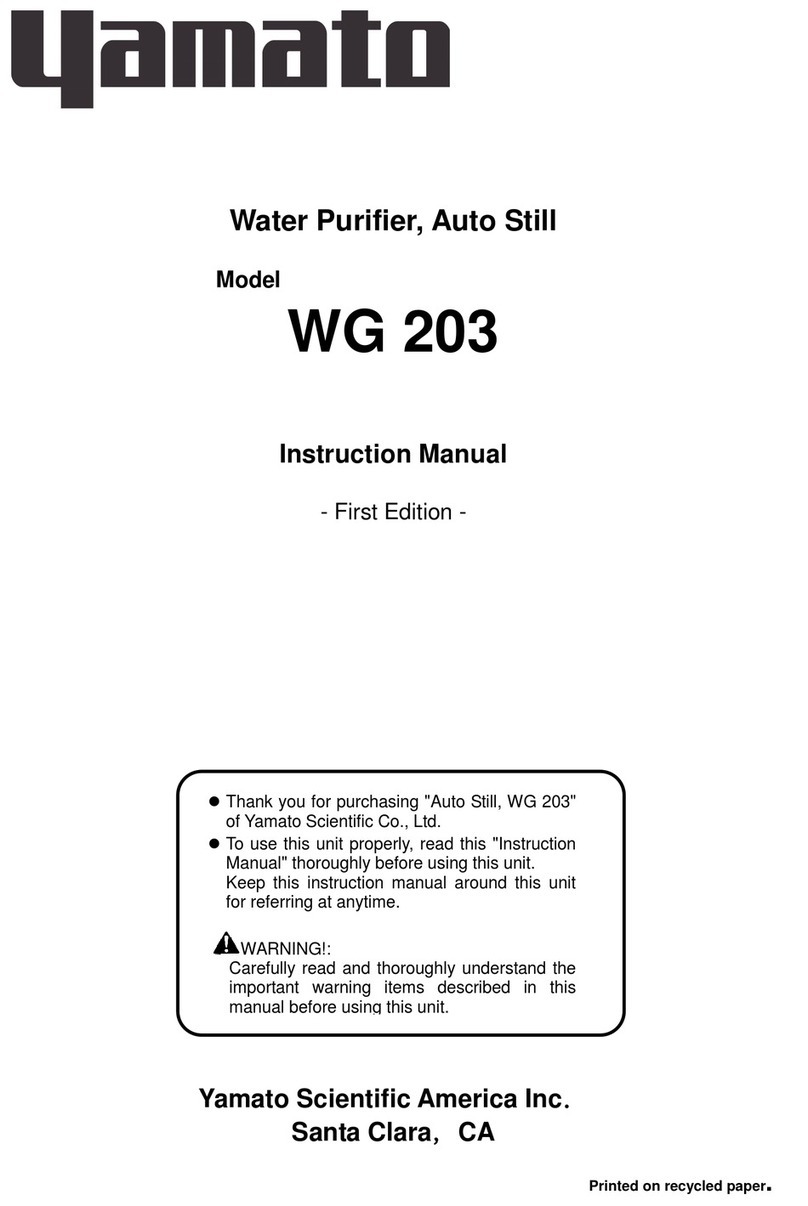
Yamato
Yamato WG 203 instruction manual

LG
LG WAW73J Series manual
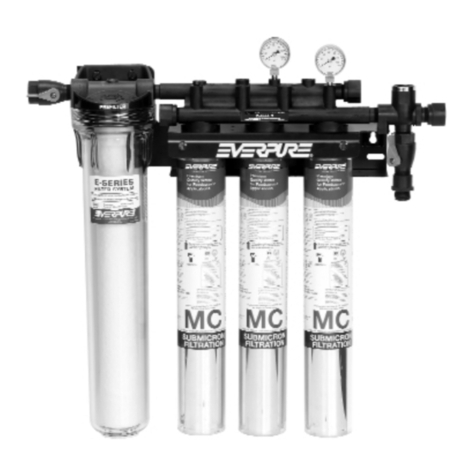
Everpure
Everpure Coldrink Series Installation and operation guide
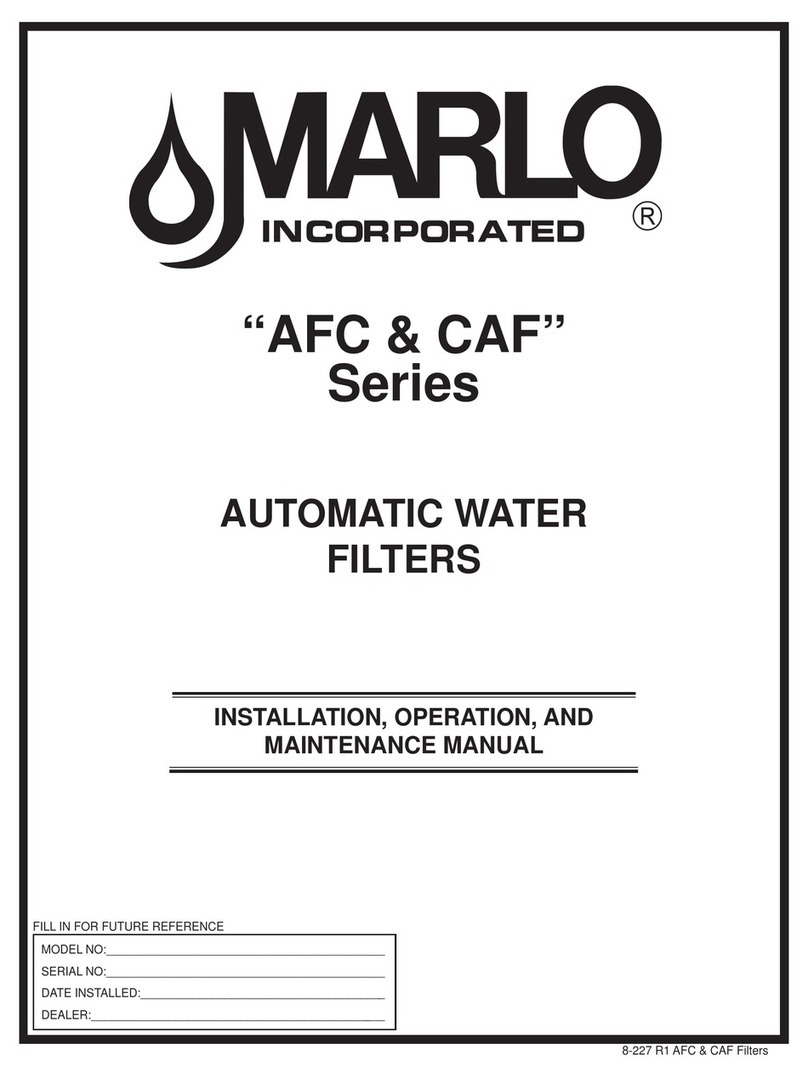
Marlo Incorporated
Marlo Incorporated AFC Series Installation, operation and maintenance manual

Frizzlife
Frizzlife MK99 installation guide
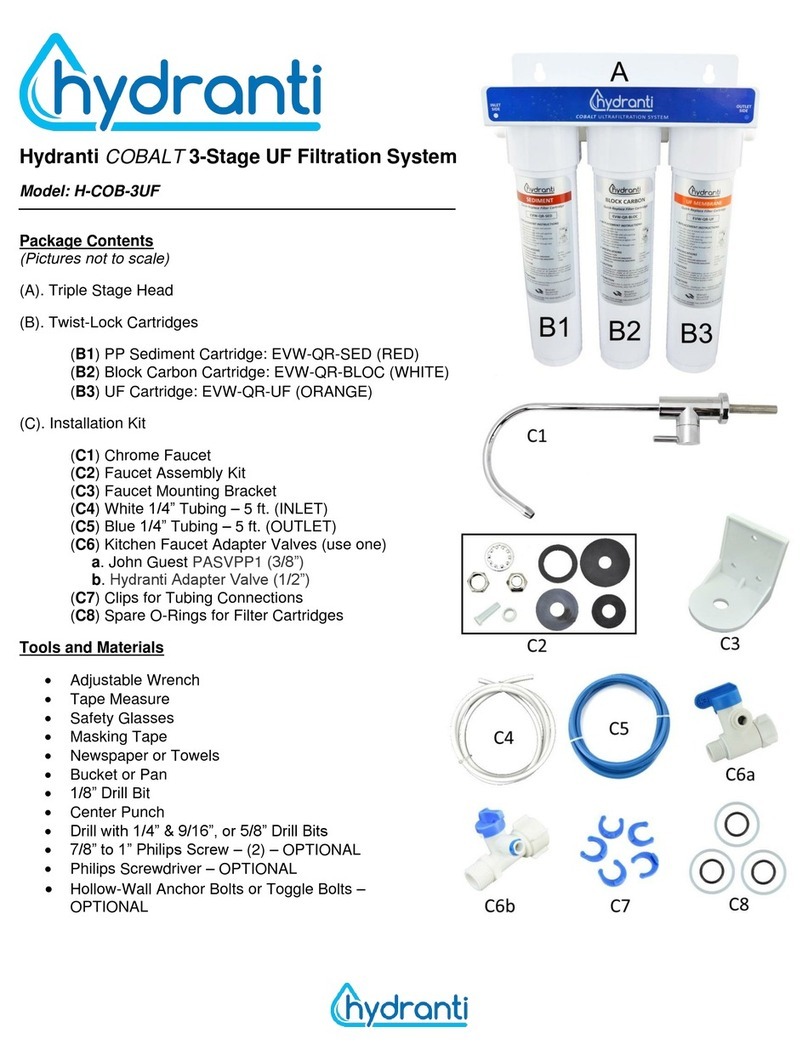
Hydranti
Hydranti COBALT H-COB-3UF manual
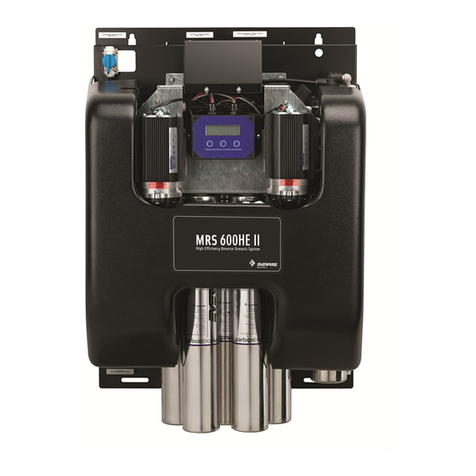
Everpure
Everpure QC7I Single-MH2 Catalog

IEM
IEM Umwelt 3 Installation and instruction manual

Aqua Optima
Aqua Optima myLAICA FB1001 Instructions and warranty

WaterGroup
WaterGroup Aquaflo H-PR-10BV-34 Installation and operating instructions
